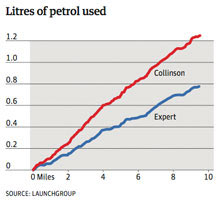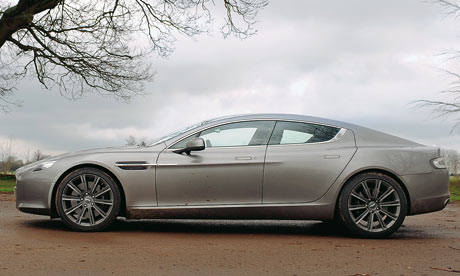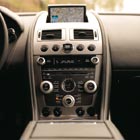
We'll admit right now that we have never been completely taken with the Aston Martin DBS. It wasn't that we didn't like it - on the contrary, it is every bit the fabulous car. It's just that we found the DBS slightly... too much, in the same way you could have too much pampering or too much caviar. Even as you're finding the words to decline the next round of Beluga you're thinking "Wow, can't believe I'm about to give this the stiffarm, but..." It is all about the fact that the DB9, to our eyes, is just right. Nothing needs to be added to it, and as fabulous as the DBS is, it marks the addition of that not-needed something.
Then the DBS Carbon Black came for a visit, so now you can consider this our about-face: the DBS – rather, this DBS – is our first choice in Astons, so much so that we'd only look at the others after driving this one into some shallow, oily grave and then giving up on hopes for its resurrection.
Gallery: Luxist Drives the Aston Martin DBS Carbon Black





It pains us to sound this worn-out note, and we take as our only consolation the fact that we aren't sweet-talking you about a Cadillac Cimmaron we're flogging on AutoTrader: the Aston Martin DBS Carbon Black looks much better in person. More accurately, it looks better than you'd ever guess from its press shots, where oddball lighting and even odder CGI and Photoshopping killed the car's blackness – which kinda kills the whole point of coming to the party.

Parked before you, its high-strength steel drenched in Carbon Black paint and accented with brightwork and carbon fiber, the car takes its place as the first OED definition of "Blacked-out." It is everything an ebony car should be: low, wide, and terribly, awfully, gloriously black. The coupe devours so many photons that the sun might even appear to rise a little later and set a little earlier. If, as a scientific experiment, you wore all black while you drove the car, scientist's fears of an Earth-based black hole would come true and you'd most likely disrupt the time-space continuum in ways that physics doesn't yet have words to describe. You could conceivably find the Planet of the Apes. It is a frighteningly black car.
It is the eating of all those visible light waves that puts the DBS Carbon Black at the top for us, because it swallows the bodywork lines and other details that highlight the DB9 structure underneath. The resulting smoothness renders it as no longer a DB9 with add-ons, but a single and whole car with a sinister line from which your eye extracts the vicious highlights: the width of the grille, the front lamps in their elongated recesses, the Magnum Silver mesh-covered ducts in the hood, the lone bit of light that manages to live on the horizontal surfaces of the car's wider rear fenders, the carbon fiber filaments supporting the mirrors.

Even the wheels earned our applause, which was another reversal since we weren't fans of them in the press shots, either. Placed in the three-dimensional world, though, the 20-inch, ten-spoke diamond-turned wheels with a graphite finish regain all of their dimensions. They aren't flat at all, with five sets of dual spokes fingering up and out from the hub and increasing in thickness, ultimately latching onto gloss black rims.
Enjoying the ocular meal every time we approached the car, it just made us want to say, "Can I get an amen?

"
Inside it's an Aston – and we should all know what that means by now – but with a few touches: semi-aniline leather and Alcantara, piano black decor with matrix alloy trim, and carbon fibers door trim and pulls. The seats are also fashioned from the fibrous stuff, and then wrapped in cross-stitched Obsidian Black leather. They save 37 pounds while maintaining full-fat comfort; we drove the car from LA to San Francisco and suffered nary an ache. We haven't met an Aston driving position that we didn't like, and the DBS keeps up with its siblings as far as that goes – the driver's seat is the perfect cubicle in which to do a day's work.
Which brings us to the first of three special points we noted about the interior. This model was a 2+2, with two optional items behind the front thrones that were referred to as "back seats." Half of that expression (hint: the first word) is true. If you had a really small baby in a really small chair it might fit in back. But really, you'll have as hard a time getting the seat in the car as the baby will understanding why you're installing him in Aston Martin's equivalent of what a supermax prison would call "The Hole." You could move the driver's seat forward, but then the cockpit isn't perfect perfection anymore. Or you could omit that back "seat" option and save yourself $3,785 dollars. It's not like you're worried about money, but that's more than the cost of the carbon black treatment itself, which only rings the till up for $2,720. Instead, get the stitched leather, two-bottle champagne holster that drapes over the rear tunnel. A much better use of that area.

The other note, pun intended, was the 13-speaker, 1,000-watt Bang & Olufsen stereo. Even mass-market premium cars are coming with some excellent audio equipment – Mercedes has Harmon-Kardon and Jaguar has Bowers & Wilkins, for instance – but this system could be even more phenomenal than you'd expect it to be. Rear speaker placement is tough in coupes, even if they have just enough space in back to not have back seats, the effect of which effectively puts you in a pure two-seater as far as sound goes: all the noise comes from the front. Playing with the balance and fader usualy just muddies things up.
Not so here. One thousand watts is a thoroughly unnecessary number best used for "Whip it out" contests and destroying your auditory canals, but B&O uses those watts wisely at all volumes: the proper sound, crisp and full, envelops the cabin properly. Sonic reproduction from CDs is outstanding, and B&O has found a way to make your average bitrate iTunes music sound so good that someone from Apple should write a 'Thank You' note to the Danish company every time you plug in your iPod. Even better, it appears that Aston has updated its iPod integration software, making the trek through your artists and playlists much more easy than it used to be.

The third point is this: an Aston cabin is a beautiful thing and simple to use. Even the navigation system, which has also had an interface upate, was a piece of proverbial bread pudding. Although we will toast the day the company jettisons the plastic doorjamb of a nav unit, it's not like we ever even used it. Due to that intergalactic blackness, see, clocks stopped wherever we went so we never had to worry about being late.
Besides, we had nowhere to be but behind the wheel burning gas – destinations were optional. Place the Emotion Control Unit in the slot and hold it there while the car clears its pipes. Be warned about that start-up: you will wake your light-sleeping neighbors on a typical residential street. No matter, though, you're now the master of a mighty machine.
The car comes standard with a six-speed manual, which is our preference even in Los Angeles, but this car had the six-speed Touchtronic 2 automatic. We are nominally not fans of paddle-shifters, but the Aston variant is excellent. We signed up for the Touchtronic 2 fan club last year after driving the DBS Volante in Pebble Beach, and there is still a rainbow that ends at a pot of gold in the transmission's bell housing. Shifts up and down are utterly seamless and damn-near instant; the psycho-electro-mechanical idea of shifting that has to travel from your brain to your flexing fingertips is the only hold-up in the equation.

But before you get to a shift, you must take off from a standstill, and that opens the door to another aspect of the unique Aston experience: the DBS is a performer, but there is almost nothing jarring about it – nearly everything happens within an envelope just short of disturbing. The 6.0-liter V12 rumbles with 510 horsepower and 420 pound-feet, the rear-wheel beneficiaries of that potentiality pushing the 3,767-pound coupe from zero to sixty miles per hour in 4.3 seconds. That's the same as a PDK-equipped, 3,161-pound Porsche 911 Carrera S, but it doesn't exactly feel it. Load up on the carbon disc brakes, 15.7-inch rotors up front with 6-piston calipers, and you'll decelerate in quadruple-time, but it only feels like double-time.
Hit the gas again and the exhaust signals its approval. That turns into a throaty wail of approval when the bypass opens up at 4,000 rpm, but still, it never gets overbearing. (Nor does it get old.) It is just enough. You can putter around town, you can set the cruise at near triple digits and enjoy the sounds of the car or the sound system, or you can point-and-shoot from turn-to-turn and have more fun than you ever would with a Canon.

Even though that brings us to the only jarring aspect of the car: it is as stiff as Marble Arch. The steering was brilliant – we could point and place the car practically by thought. If the road was smooth as sour cream, we owned it. Owned. If the road wasn't, as LA's canyon roads tend not to be, the car did a stutter-step through every turn. Even the Adaptive Damping System couldn't overcome the DBS' skittishness. Having worked our way from smooth twisties to bumpy, at first we couldn't figure out where the DBS' immaculate manners went, especially when we remembered driving the DBS Volante last summer on a pockmarked Carmel Valley Road and being chuffed by its agility.
Then we remembered a colleague's review of the 2009 Aston Martin V8 Vantage, wherein he regretted that the coupe was so stiff that he'd choose the convertible without the twist-minimizing Sport Pack. We would still take the DBS coupe just because that's how we roll, even though it doesn't have a Sport Pack option that we could un-check. But we'd miss the Volante when it came time to manhandle any esses that featured irregular road surfaces. Let's keep things in context, though – the DBS is fantastic even when it's letting you know how unyielding it is. But the mere fact that it is unyielding in that one instance, when otherwise it is a pile of Carbon and Obsidian Black warm fuzzies, makes that one instance stand out.

No matter, for $283,350 we'd take it immediately. Get rid of the back "seat" and we could even get the price below an even $280K – not that our wealth management team would care about that trifle. Nor would it care that we'd probably turn right around and spend that money on a larger gas tank, since the 12/18 EPA numbers work to keep the 20.5-gallon unit regularly free of octane. Again, no matter. Piety is a priceless affair, and we found the DBS Carbon Black the motoring equivalent of The Lord's Prayer: a reverent way to worship the act of driving, and an everyday reason to intone, "Amen."
Tags: aston martin, aston martin dbs, aston martin dbs carbon black edition, dbs carbon black, dbs volante
Filed under: Luxury Cars & Autos
 Getty Images Pontiac GTO: Accessible for collectors on a budget.
Getty Images Pontiac GTO: Accessible for collectors on a budget. 


 Obama eulogizes civil rights leader Dorothy Height, hails her examples of public service By ANITA CHANGAssociated Press Writer
Obama eulogizes civil rights leader Dorothy Height, hails her examples of public service By ANITA CHANGAssociated Press Writer











 "
"




 Gulf Oil Saudi Arabia Holds Aston Martin Vantage Gt4 Test Drive In Abu Dhabi Posted: 28-04-2010 , 13:31 GMT
Gulf Oil Saudi Arabia Holds Aston Martin Vantage Gt4 Test Drive In Abu Dhabi Posted: 28-04-2010 , 13:31 GMT  The Aston Martin Racing Team was in attendance for the event, accompanied by Aston Martin Racing Chairman Mr. David Richards. Also, present was COO of Dabbagh Group Mr. Waheed A. Shaikh; Mr. Sajid Saeed, Gulf Oil Saudi Arabia Exec. Vice President; Mr. Sameer Fakeeh Vice President Sales at Gulf Oil Saudi Arabia; Mr. Talib Khushnood, Gulf Oil General Manager of sales; and Mr. Sulaiman Shaukat (Brand Manager - Gulf Oil Saudi Arabia.
The Aston Martin Racing Team was in attendance for the event, accompanied by Aston Martin Racing Chairman Mr. David Richards. Also, present was COO of Dabbagh Group Mr. Waheed A. Shaikh; Mr. Sajid Saeed, Gulf Oil Saudi Arabia Exec. Vice President; Mr. Sameer Fakeeh Vice President Sales at Gulf Oil Saudi Arabia; Mr. Talib Khushnood, Gulf Oil General Manager of sales; and Mr. Sulaiman Shaukat (Brand Manager - Gulf Oil Saudi Arabia.